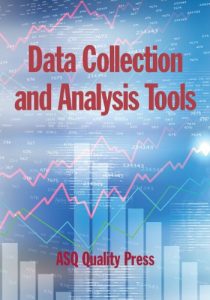How can you collect the data you need, and what should you do with them once they’re collected?
Included in this straightforward, how-to book is a description, when to use, procedure, and example for the following tools that can be used to collect or analyze data:
Box and Whisker Plot: A tool used to display and analyze multiple sets of variation data on a single graph.
Check sheet: A generic tool that can be adapted for a wide variety of purposes, the check sheet is a structured, prepared form for collecting and analyzing data.
Control chart: A graph used to study how a process changes over time. Comparing current data to historical control limits leads to conclusions about whether the process variation is consistent (in control) or is unpredictable (out of control, affected by special causes of variation).
Design of experiments: A method for carrying out carefully planned experiments on a process. Usually, design of experiments involves a series of experiments that start by looking broadly at a great many variables and then focus on the few critical ones.
Histogram: The most commonly used graph for showing frequency distributions, or how often each different value in a set of data occurs.
Scatter diagram: A diagram that graphs pairs of numerical data, one variable on each axis, to look for a relationship.
Stratification: A technique that separates data gathered from a variety of sources so that patterns can be seen.
Survey: Data collected from targeted groups of people about their opinions, behavior or knowledge.
Included in this straightforward, how-to book is a description, when to use, procedure, and example for the following tools that can be used to collect or analyze data:
Box and Whisker Plot: A tool used to display and analyze multiple sets of variation data on a single graph.
Check sheet: A generic tool that can be adapted for a wide variety of purposes, the check sheet is a structured, prepared form for collecting and analyzing data.
Control chart: A graph used to study how a process changes over time. Comparing current data to historical control limits leads to conclusions about whether the process variation is consistent (in control) or is unpredictable (out of control, affected by special causes of variation).
Design of experiments: A method for carrying out carefully planned experiments on a process. Usually, design of experiments involves a series of experiments that start by looking broadly at a great many variables and then focus on the few critical ones.
Histogram: The most commonly used graph for showing frequency distributions, or how often each different value in a set of data occurs.
Scatter diagram: A diagram that graphs pairs of numerical data, one variable on each axis, to look for a relationship.
Stratification: A technique that separates data gathered from a variety of sources so that patterns can be seen.
Survey: Data collected from targeted groups of people about their opinions, behavior or knowledge.












